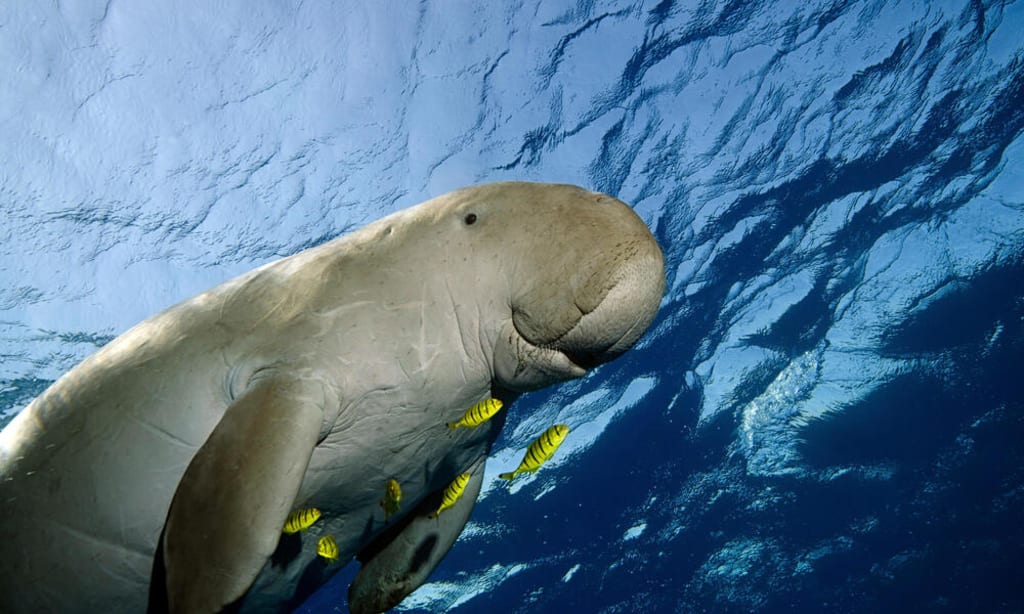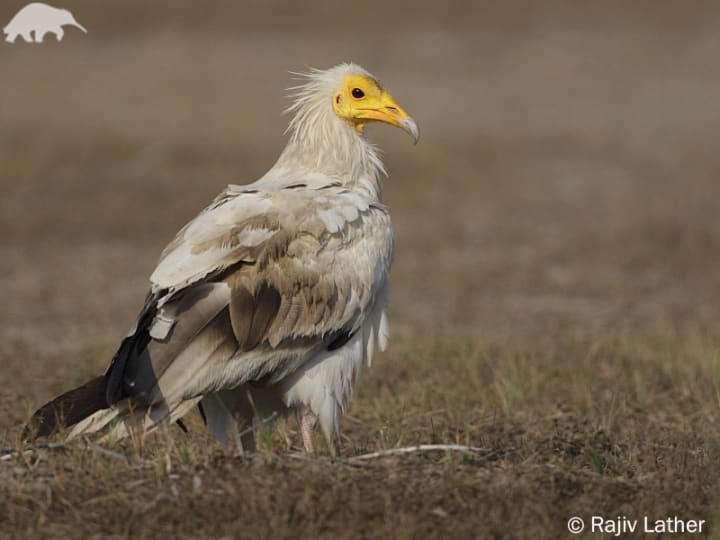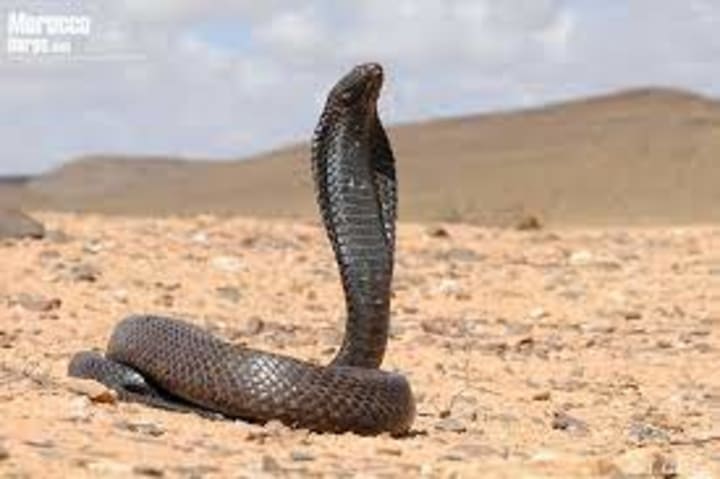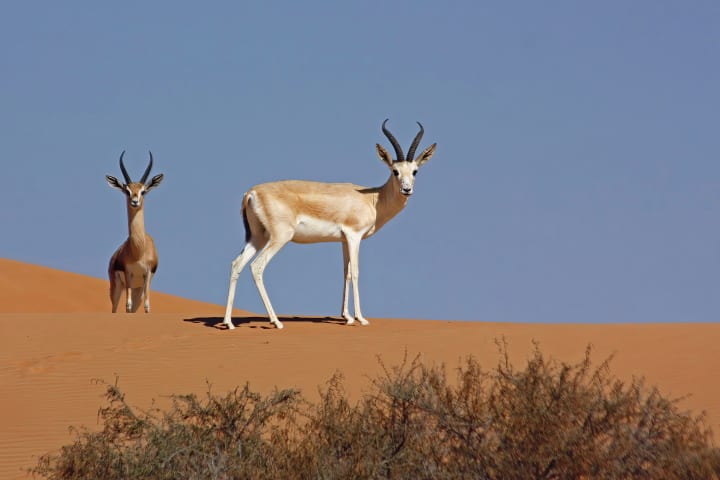10 Endangered species in Egypt
Dugong (Dugong dugon), Slender-billed Curlew (Numenius tenuirostris), Sand Gazelle (Gazella marica), Northern Bald Ibis (Geronticus eremita)

1., Egyptian Vulture (Neophron percnopterus):

The Egyptian Vulture (Neophron percnopterus) is a species of bird of prey that is native to Egypt and several other regions around the world. Here are some key details about this endangered species:
Description: The Egyptian Vulture is a medium-sized vulture with a wingspan of about 160-180 cm (63-71 inches). It has white plumage, a yellow face, and a slender, curved beak. Adult birds have dark feathers on their wings, while juveniles have brown plumage.
Habitat: These vultures inhabit a range of habitats, including deserts, open plains, and mountainous regions. They are often found near cliffs and rocky areas where they build their nests.
Diet: Egyptian Vultures primarily feed on carrion (dead animals). However, they also have unique feeding behaviors, including using tools to crack open eggs and stones to break bones.
Endangered Status: The Egyptian Vulture is considered critically endangered in Egypt. The population has declined significantly due to various threats, including habitat loss, electrocution on power lines, poisoning from pesticides, and illegal hunting.
Conservation Efforts: Several conservation organizations and government agencies are working to protect the Egyptian Vulture. Conservation efforts include habitat restoration, raising awareness about the species, implementing anti-poisoning campaigns, and establishing protected areas.
Migration: Egyptian Vultures are migratory birds, and they undertake long-distance migrations between breeding and wintering grounds. They breed in Europe and Central Asia and winter in Africa, including Egypt.
Breeding Behavior: Egyptian Vultures are monogamous and form long-term pair bonds. They build their nests on cliffs or trees and typically lay one to three eggs. Both parents participate in incubation and raising the chicks.
Cultural Significance: The Egyptian Vulture holds cultural significance in Egypt and is associated with ancient Egyptian mythology. It was considered sacred and represented as the goddess Nekhbet, the protector of Upper Egypt.
It is important to continue efforts to protect and conserve the Egyptian Vulture and its habitats to ensure the survival of this magnificent bird species.
2., Egyptian Tortoise (Testudo kleinmanni):

The Egyptian Tortoise (Testudo kleinmanni) is a small tortoise species endemic to Egypt and parts of Libya and Israel. Here are some key details about this critically endangered species:
Description: The Egyptian Tortoise is a small-sized tortoise, with adults typically measuring around 12-15 centimeters (4.7-5.9 inches) in length. They have a high-domed carapace (upper shell) that is typically yellowish to tan in color, and their skin is dark brown.
Habitat: These tortoises inhabit arid and semi-arid regions, including coastal dunes, sandy plains, and rocky areas. They are well adapted to desert environments and can withstand high temperatures.
Endangered Status: The Egyptian Tortoise is critically endangered in Egypt. The population has dramatically declined due to habitat destruction, urbanization, overgrazing by livestock, and illegal collection for the pet trade.
Feeding Habits: Egyptian Tortoises are herbivorous and primarily feed on various plant species, including grasses, succulents, and desert flowers. They have a specialized diet adapted to their arid habitats.
Reproduction: These tortoises reach sexual maturity at around 7-10 years of age. They lay small clutches of 1-3 eggs, which they bury in the ground. The incubation period is approximately 90-120 days.
Conservation Efforts: Conservation organizations and government agencies are working to protect the Egyptian Tortoise. Conservation efforts include raising awareness about the species, implementing habitat restoration programs, enforcing legal protections, and promoting captive breeding programs.
Trade and Legal Protection: The Egyptian Tortoise is listed under Appendix I of the Convention on International Trade in Endangered Species of Wild Fauna and Flora (CITES), which prohibits the international commercial trade of this species. In Egypt, it is also protected under national legislation.
Importance in Ecosystems: Egyptian Tortoises play a vital role in their ecosystems as seed dispersers and grazers. Their burrows provide shelter for other animals, and their feeding habits help maintain vegetation balance.
Preserving the remaining habitats of the Egyptian Tortoise and addressing the threats it faces are crucial for its long-term survival. Conservation efforts should focus on habitat protection, community engagement, and sustainable management practices to ensure the species' future.
3., Nile Softshell Turtle (Trionyx triunguis):

The Nile Softshell Turtle (Trionyx triunguis), also known as the African Softshell Turtle or African Mud Turtle, is a species of freshwater turtle native to Egypt, as well as other parts of Africa and the Middle East. Here is some information about this endangered species:
Description: The Nile Softshell Turtle is a large freshwater turtle characterized by its soft, leathery shell. It has a streamlined body with webbed feet, which make it well adapted for swimming. The shell is brownish-gray in color and lacks the hard scutes found in other turtle species.
Habitat: These turtles are primarily found in freshwater habitats, such as rivers, lakes, and marshes. They prefer areas with sandy or muddy bottoms where they can bury themselves partially to ambush prey.
Diet: Nile Softshell Turtles are carnivorous and primarily feed on a variety of aquatic prey, including fish, crustaceans, insects, and amphibians.
Endangered Status: The Nile Softshell Turtle is considered endangered in Egypt. The species has experienced significant population declines due to habitat degradation, water pollution, overfishing, and collection for the pet trade.
Reproduction: Female Nile Softshell Turtles lay their eggs in sandy or muddy areas close to water bodies. They typically lay clutches of 10-30 eggs. The incubation period lasts around 60-80 days, depending on environmental conditions.
Conservation Efforts: Conservation organizations and governmental bodies are working to protect the Nile Softshell Turtle. Conservation efforts include habitat restoration, raising public awareness about the species, implementing regulations on trade and collection, and supporting captive breeding and reintroduction programs.
Threats: The main threats to Nile Softshell Turtles in Egypt include habitat loss and degradation caused by urbanization, agriculture, and infrastructure development. Additionally, water pollution, overfishing, and incidental capture in fishing gear pose significant risks to their populations.
Importance in Ecosystems: Nile Softshell Turtles play an important ecological role as predators, helping to control populations of aquatic invertebrates, fish, and amphibians. They also contribute to nutrient cycling by consuming carrion and organic matter.
Efforts to protect the remaining habitats of the Nile Softshell Turtle and mitigate the threats it faces are essential for its conservation. Collaboration between stakeholders, including researchers, conservationists, and local communities, is crucial for the long-term survival of this species.
4., Egyptian Mongoose (Herpestes ichneumon):

The Egyptian Mongoose (Herpestes ichneumon) is a small carnivorous mammal native to Egypt and various other regions in Africa, Europe, and the Middle East. Here is some information about this endangered species:
Description: The Egyptian Mongoose is a slender and agile mammal with a long body, a pointed snout, and a bushy tail. It has short legs and a coat of fur that ranges in color from gray to reddish-brown. The mongoose can reach a length of about 40-60 cm (16-24 inches), excluding its tail.
Habitat: These mongooses are found in a variety of habitats, including forests, grasslands, wetlands, and agricultural areas. They are often associated with water sources, such as rivers, lakes, and marshes.
Diet: Egyptian Mongooses are opportunistic predators with a diverse diet. They primarily feed on small mammals, birds, reptiles, amphibians, insects, and occasionally, fruits and other plant matter.
Endangered Status: The Egyptian Mongoose is considered endangered in Egypt. The species has faced population declines due to habitat loss and fragmentation caused by agricultural expansion, urbanization, and the construction of infrastructure.
Behavior: Egyptian Mongooses are primarily diurnal, being active during the day. They are known for their agility and are excellent climbers and swimmers. They are solitary animals, except during the mating season.
Reproduction: Breeding usually occurs during the rainy season. Female mongooses give birth to a litter of around 2-4 offspring after a gestation period of about 60 days. The young mongoose are relatively independent within a few months.
Conservation Efforts: Efforts are being made to conserve the Egyptian Mongoose in Egypt. Conservation initiatives focus on protecting its habitats, raising awareness about the species, and implementing measures to mitigate habitat destruction and human-wildlife conflicts.
Ecological Role: Egyptian Mongooses play a beneficial role in ecosystems as they help control populations of rodents and other small mammals, which can have significant impacts on agriculture and disease transmission.
It is crucial to continue conservation efforts to protect the remaining populations of Egyptian Mongooses and their habitats. Conservation measures should aim to promote sustainable land use practices, minimize human-wildlife conflicts, and raise awareness about the importance of conserving this species.
5., Egyptian Cobra (Naja haje):

The Egyptian Cobra (Naja haje) is a venomous snake species found in Egypt and various other regions in Africa and the Middle East. Here is some information about this endangered species:
Description: The Egyptian Cobra is a venomous snake known for its distinct hood, which it spreads when threatened. It has a slender body, typically ranging from 1.2 to 2 meters (4 to 6.6 feet) in length. The coloration can vary, but it is usually light brown or olive with dark markings.
Habitat: These cobras inhabit a range of habitats, including deserts, grasslands, rocky areas, and cultivated fields. They are adaptable and can also be found near human settlements.
Venom: The Egyptian Cobra possesses potent neurotoxic venom, which it delivers through its fangs. The venom can cause severe symptoms and can be lethal to humans if not treated promptly.
Endangered Status: The Egyptian Cobra is considered endangered in Egypt. The species has faced population declines due to habitat loss, fragmentation, and degradation. Additionally, they are often persecuted and killed out of fear or as a response to potential threats to humans.
Behavior: Egyptian Cobras are primarily active at night, although they can also be active during the day. They are generally shy and prefer to escape when confronted. However, if threatened or cornered, they will assume a defensive posture, raising their hoods and hissing as a warning.
Diet: These cobras feed primarily on small mammals, birds, lizards, and other snakes. They are skilled hunters and use their venom to immobilize and subdue their prey.
Conservation Efforts: Conservation efforts for the Egyptian Cobra involve promoting awareness about the importance of snakes in ecosystems, implementing measures to reduce human-snake conflicts, and conserving their natural habitats.
Importance in Ecosystems: Egyptian Cobras play a vital role in ecosystems as both predators and prey. They help control populations of small mammals and maintain a balance within the food chain.
It is essential to promote conservation and educate communities about the importance of coexisting with venomous snakes like the Egyptian Cobra. Encouraging responsible snake management practices and minimizing the destruction of their habitats can contribute to the long-term survival of this species.
6., Hawksbill Turtle (Eretmochelys imbricata):

The Hawksbill turtle (Eretmochelys imbricata) is a species of sea turtle that is recognized for its unique appearance and ecological importance. Here are some key points about the Hawksbill turtle:
Physical Characteristics: Hawksbill turtles are named for their narrow, pointed beak, which resembles a hawk's bill. They have a relatively small head in proportion to their body size and a distinct pattern of overlapping scales on their shell, known as scutes. Their carapace (shell) is typically brownish or olive in color with streaks of amber, and their undersides are lighter in color.
Size: Adult Hawksbill turtles can reach a length of about 2.5 to 3 feet (80-90 cm) and weigh around 100-150 pounds (45-68 kg), although some individuals can grow larger.
Distribution: Hawksbill turtles are found in tropical and subtropical waters of the Atlantic, Pacific, and Indian Oceans. They are known to inhabit coral reefs, rocky areas, and shallow coastal regions.
Diet: Hawksbill turtles are primarily spongivores, which means they feed on sponges. They have a narrow head shape and specialized beak that allows them to reach into crevices and feed on sponges that other turtles cannot access. They also consume other invertebrates, such as jellyfish, sea anemones, and crustaceans.
Conservation Status: Hawksbill turtles are listed as critically endangered by the International Union for Conservation of Nature (IUCN). They face numerous threats, including habitat loss, pollution, entanglement in fishing gear, and illegal trade of their shells, which are highly valued for their use in jewelry and decorative items.
Importance to Ecosystems: Hawksbill turtles play a crucial role in maintaining the health of coral reef ecosystems. By feeding on sponges, they prevent the sponges from overgrowing and competing with corals for space. This helps maintain a balance within the reef community, allowing corals to thrive.
Reproduction: Hawksbill turtles reach sexual maturity between 20 and 40 years of age. They typically nest on beaches, returning to the same area where they were hatched. Female Hawksbills lay around 100-150 eggs in each nest and may nest several times during a nesting season. The incubation period is around 60 days, and hatchlings emerge from the nest and make their way to the ocean.
Efforts are being made worldwide to protect and conserve the Hawksbill turtle population through measures such as habitat preservation, nesting beach protection, and reducing threats from fishing and illegal trade. These conservation initiatives are essential to ensure the survival of this critically endangered species.
7., Dugong (Dugong dugon):

The Dugong (Dugong dugon) is a fascinating marine mammal that is closely related to manatees. Also known as the "sea cow," the Dugong is the only living representative of the family Dugongidae. Here are some key facts about the Dugong:
Physical Characteristics: Dugongs are large animals with a streamlined body shape, tapered tail, and paddle-like flippers. They have a grayish-brown to bluish-gray skin, which is sparsely covered with coarse hair. Dugongs have a distinctive snout with a downturned mouth and bristled whiskers used for feeding.
Distribution: Dugongs are found in warm coastal waters of the Indian Ocean and the western Pacific Ocean. They inhabit shallow, protected areas such as seagrass meadows, mangrove swamps, and lagoons, primarily in tropical and subtropical regions.
Size: Adult Dugongs can grow up to 10 feet (3 meters) in length and weigh between 600 and 1,100 kilograms (1,300 to 2,400 pounds). Females are generally larger than males.
Diet: Dugongs are herbivorous mammals and are strictly marine grazers. Their diet consists mainly of seagrasses, which they feed on by uprooting the plants with their strong lips and grinding them with their specially adapted teeth. They can consume large quantities of seagrass daily to meet their nutritional needs.
Behavior: Dugongs are generally solitary animals, although they may form small groups or pairs. They are known for their slow and graceful swimming, often cruising just below the water's surface. Dugongs can hold their breath for several minutes before resurfacing. They are predominantly diurnal, meaning they are active during the day.
Conservation Status: The Dugong is listed as vulnerable by the IUCN. Like many marine species, Dugongs face numerous threats, including habitat loss, pollution, entanglement in fishing gear, boat collisions, and overfishing of their seagrass habitats. Additionally, they are often hunted for their meat, oil, and bones, making them susceptible to illegal hunting and poaching.
Reproduction: Dugongs have a slow reproductive rate. Females reach sexual maturity at around 6 to 17 years of age, while males mature slightly later. They give birth to a single calf after a gestation period of about 13 to 15 months. The calf remains dependent on its mother for around 18 months, during which time it nurses and learns essential skills for survival.
Conservation efforts are underway to protect Dugong populations and their habitats. These initiatives include the establishment of marine protected areas, conservation education, habitat restoration, and sustainable fishing practices. Collaborative efforts between governments, conservation organizations, and local communities are crucial for the long-term survival of these unique marine mammals.
8., Slender-billed Curlew (Numenius tenuirostris):

The Slender-billed Curlew (Numenius tenuirostris) is a migratory bird species that is known for its elusive nature and critically endangered status. Here are some key details about the Slender-billed Curlew:
Physical Characteristics: The Slender-billed Curlew is a medium-sized wading bird belonging to the family Scolopacidae. It has a distinctively long and slender bill, which gives the species its name. The plumage is mainly brown with streaks and a paler underside. During the breeding season, adult males display a reddish-brown coloration on their neck and chest.
Distribution: The Slender-billed Curlew is one of the world's rarest bird species. Historically, it had a broad breeding range extending across the grasslands and wetlands of Siberia and Central Asia. During the non-breeding season, it would migrate southwards, primarily to the Mediterranean region, including countries such as Italy, Greece, Turkey, and Morocco. However, the species' population has drastically declined, and its current breeding and wintering grounds are not well known.
Conservation Status: The Slender-billed Curlew is classified as critically endangered by the IUCN. The population has declined dramatically, and the species is now considered possibly extinct. The last confirmed sighting of the Slender-billed Curlew occurred in 1995 in Russia. Despite extensive efforts to locate and study the bird, no conclusive evidence of its continued existence has been found. The species faces threats such as habitat loss, degradation of wetlands, hunting, and climate change.
Behavior and Ecology: Little is known about the behavior and ecology of the Slender-billed Curlew due to its elusive nature and rarity. It is believed to feed on invertebrates, such as insects and worms, which it probes for with its long bill in wetland habitats. During the breeding season, the species is thought to construct shallow nests on the ground in grassy areas.
Conservation Efforts: Conservation organizations and researchers have made concerted efforts to locate and study the Slender-billed Curlew. Surveys, research expeditions, and monitoring programs have been conducted in potential breeding and wintering areas. However, the limited sightings and lack of confirmed records have made conservation efforts challenging. The species is included in various international conservation agreements, and there are ongoing campaigns to raise awareness about its plight and the importance of habitat protection.
The Slender-billed Curlew's status as one of the world's most enigmatic and endangered bird species highlights the urgent need for conservation action. Continued research, habitat preservation, and international collaboration are crucial for the potential rediscovery and conservation of this elusive and iconic bird.
9., Sand Gazelle (Gazella marica):

Physical Characteristics: The Sand Gazelle is a medium-sized gazelle with a slender build. It has a light sandy to light reddish-brown coat, which helps it blend in with its desert surroundings. The gazelle has distinctive white patches on its face, rump, and underbelly. Both males and females have curved, ringed horns, although the horns of males are typically larger and more robust.
Distribution: The Sand Gazelle is native to desert regions of North Africa and the Arabian Peninsula. Its range extends across countries such as Morocco, Algeria, Tunisia, Libya, Egypt, Saudi Arabia, Oman, Yemen, and the United Arab Emirates. It is adapted to live in arid and semi-arid habitats, including sandy deserts, gravel plains, and rocky terrains.
Habitat and Adaptations: Sand Gazelles are highly adapted to desert life. They can withstand high temperatures and arid conditions by conserving water and obtaining moisture from their food. They have specialized kidneys that allow them to reabsorb water efficiently, reducing water loss. Their large, concave hooves help them walk on sandy terrain without sinking. They are also well-suited for rapid running, allowing them to escape predators.
Behavior: Sand Gazelles are primarily active during the early morning and late afternoon to avoid the intense heat of the day. They are social animals and typically form small herds consisting of females, young, and a dominant male. During the breeding season, males engage in territorial displays and fights to establish dominance and access to females.
Diet: Sand Gazelles are herbivores and primarily feed on desert vegetation, including grasses, leaves, and shrubs. They have adapted to survive on low-quality, fibrous vegetation found in arid environments.
Conservation Status: The Sand Gazelle is classified as vulnerable by the IUCN. The species faces several threats, including habitat loss, degradation, and fragmentation due to human activities such as agriculture, infrastructure development, and overgrazing by domestic livestock. Additionally, hunting for meat and sport has also impacted the population of Sand Gazelles.
Conservation efforts, including habitat protection, establishment of protected areas, and captive breeding programs, are crucial for the survival of the Sand Gazelle. Efforts are also underway to raise awareness about the importance of conserving this unique desert-dwelling species and its fragile ecosystem.
10., Northern Bald Ibis (Geronticus eremita):

The Northern Bald Ibis (Geronticus eremita), also known as the Waldrapp or Hermit Ibis, is a distinctive bird species known for its bald head and long, curved beak. Here are some key facts about the Northern Bald Ibis:
Physical Characteristics: The Northern Bald Ibis is a medium-sized bird, measuring about 70-80 cm (28-31 inches) in length. It has a glossy black plumage with metallic green and purple hues. The head and neck lack feathers, giving the bird its bald appearance. The beak is long and curved, and during the breeding season, adults develop bushy plumes on the throat and upper breast.
Distribution: Historically, the Northern Bald Ibis had a wide distribution across Europe, the Middle East, and parts of North Africa. However, due to habitat loss and hunting, the species became extinct in many regions. Currently, the Northern Bald Ibis is primarily found in small, isolated populations in Morocco, Turkey, and southern Europe, particularly in Spain.
Habitat: The Northern Bald Ibis prefers open habitats such as semi-arid steppes, rocky cliffs, and coastal areas. It often roosts and nests on cliffs, using ledges and crevices for protection.
Behavior: The Northern Bald Ibis is a social bird and forms colonies during the breeding season. It is known for its migratory behavior, with populations undertaking long-distance journeys between breeding and wintering grounds. These birds are diurnal and forage primarily during the day, using their long beaks to probe the soil and catch insects, small reptiles, and invertebrates.
Conservation Status: The Northern Bald Ibis is classified as critically endangered by the IUCN. The species has experienced significant population declines and range contractions due to habitat loss, disturbance, hunting, and pesticide use. Efforts are underway to reintroduce and establish new populations, with conservation organizations working on habitat restoration, captive breeding, and community involvement to protect the species.
Cultural Significance: The Northern Bald Ibis holds cultural and historical significance. It was once revered and depicted in ancient Egyptian and Mesopotamian art. The species has also been associated with religious and mythical beliefs in various cultures.
Conservation initiatives and international collaborations aim to protect and restore the Northern Bald Ibis population. The focus is on preserving critical habitats, raising awareness, and engaging local communities in conservation efforts. Through these endeavors, the hope is to secure the future of this unique and endangered bird species.






Comments
There are no comments for this story
Be the first to respond and start the conversation.